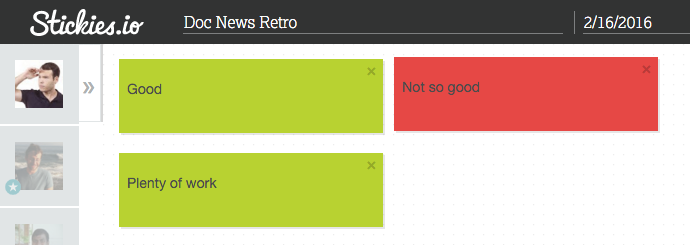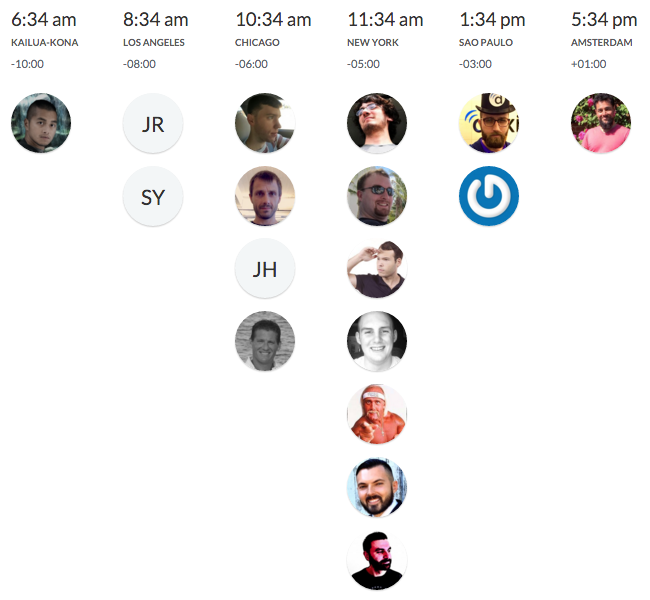Although headquartered in San Francisco, Doximity has a thriving remote work culture. While the office is the historical hub of activity, a large portion of our hiring over the last several months has been remote workers. Remote employees might take a back seat to on-site workers in a lot of offices, but, at Doximity, remote workers are first-class citizens.
Meetings and Communication
We strive to stay as lean and agile as possible and to create a culture that isn’t overly focused on meetings. That doesn’t mean we’re opposed to them — in fact it’s quite the opposite. Person-to-person communication is important and fosters a sense of connection and team building. To put that into a real-world perspective, you’re not going to have meetings all day, and the ones you do have are quick, focused, and important. As a company, we’ve invested in the infrastructure to make these more seamless and plan to keep that up as we grow.
A little bit about company structure: there are several different main teams, each working on a different product. For example, on the DocNews team, we begin the day with a standup meeting. Each participant is expected to talk about what was done the day before, what they'll be working on that day, and any blockers they may have encountered. It’s a good way to stay in contact with the team and, in addition to the intrinsic value of the standup, makes remote employees feel connected. Not every team does stand-ups but the infrastructure and options are there.
“Estimation meetings” are used to gauge how many points to assign to different stories. We talk about the feature and all give a thumbs up when we’re ready to estimate. Estimating points is done in a rock-paper-scissors-esque manner where we count to three and then put up fingers corresponding to the number of points we think a story should take. If we have different opinions on point assignments, we take time justify our position.
We recently started using a web app called Stickies for our retrospectives. This lets remotes participate just like they were in the room. We also use live video chat during the meeting and collaborate using the app and Slack. Read more about retrospectives at Doximity to get more insight into how they work for us.

Pair programming is also something we remoters do occasionally. This is generally up to the people who want to pair; we don’t force mandatory pairing time. Schedules permitting, coworkers are almost always up for pairing. We’ve mostly used Skype for this, but we also occasionally use tmux and a shared connection.
Hardware and Software
We use the typical tools to manage communication across our team:
Slack
We use Slack for pretty much everything. In-office text communication is done with Slack, which puts remote workers on the same playing field as everyone else. All of our deploys are done via in-house software which is controlled via bot. This lets any engineer have visibility into what's happening at all times. Most teams have their own channels (or several) where pertinent data is accessible, and the same applies to shared roles such as QA.
Everything Else
We make use of Google Hangouts, Skype and appear for video chats and screen sharing. Now that Slack is testing out video and audio chats, we may start using that more actively. Skype is slowly being phased out but we do have employees who prefer it.
Occasionally, we’ll use a remote tmux session for pairing. When that isn’t feasible, we use Screenhero. Our timezone account gives us a nice view of current times for remoters.

Hardware
Some of our conference rooms have recently been outfitted with Chromeboxes, which have exceptional video and audio quality. These help tremendously and have the least amount of headaches when setting up.
In Person Visits
Even though working remote has tons of benefits, so does face-to-face interaction. Remote workers can visit the office every couple of months between our off-sites. We have two corporate lofts very close to the office where employees can stay.
New employees come to the office for their first week. This time functions as an introduction to the office, team, products, and the process. Developers are expected to make a commit and production deploy on their first day. There is also a series of presentations that teach about the company, culture, and introduce new hires to their coworkers.

Working in the office also means you can hang out at the J-Bar, an office staple. As the name suggests, there is alcohol available should you wish to partake, as well as a gorgeous view of San Francisco. It’s also where we do our lunch and learns, meet-ups, and larger meetings. There is a camera and mic setup where remote participants can see and hear what’s going on as well as ask questions and interact with the presenter.
We also have off-sites every quarter. The off-site locations are different each quarter so we get to experience new places. With a diverse and remote team, off-sites are a chance to get everyone together in person. This helps to maintain the culture and provide an opportunity for everyone to realign and prioritize goals. We also share what we’ve learned and worked on the previous quarter and squash outstanding bugs in our bug bash.
A full development retrospective is done at each off-site. We try and concentrate on larger issues affecting all teams. I’m not trying to imply it’s all smooth sailing — it took a while to have a consensus on whether 80 or 120 characters is the proper line length for a Ruby file. (It’s 80, in case you were wondering.)
We’re Hiring
If you like what you hear about our remote environment, drop us a line and follow us on twitter. We’re hiring, and, obviously, remote workers are welcome :)
Special thanks to Bruno Miranda, Ben Fischer, Jaymes Waters, Greg Lombardo, and Daniel Zajic, and all Dox remoters for their feedback with this article.
